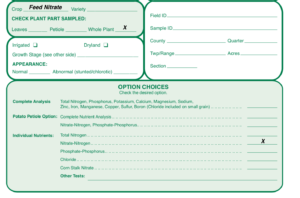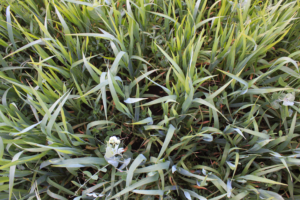Feed Nitrate Testing in a Drought Year
Drought is an unwelcome but well-known phenomenon on the Northern Plains and Canadian Prairies. Rainfall has been sparse and scattered across the region, and high temperatures exceeding 90 to 100° F (32 to 38° C) have already caused stress to young crops. These same stresses have also wracked pastures, prompting livestock producers to think about alternative feed options for cattle. Believe it or not, we have already received questions from farmers and ranchers about decisions to cut and bale or graze small grain fields for livestock feed.
When drought-stressed annual crops (e.g., wheat, barley, oat, corn) are cut or grazed, producers must exercise caution about livestock nitrate poisoning when feeding these forages. Drought-stressed crops often accumulate nitrate because plant uptake of nitrate exceeds plant growth and nitrogen utilization. Nitrate is usually concentrated in lower plant parts (lower stem or stalk). When livestock, particularly sheep and cattle, ingest forages with a high nitrate content, nitrate poisoning can occur if large amounts of nitrate convert to nitrite in their digestive system.
Dry soil conditions and high soil nitrate levels favor plant accumulation of nitrate. There is one upside to very dry soil conditions: Some soils may not have had enough soil water to convert all nitrogen fertilizer from the ammonium form to the nitrate form, especially if nitrogen fertilizer was applied in a concentrated band that delays nitrification. Therefore, this may limit the amount of soil nitrate available for plant uptake and accumulation. Regardless, there is still variation across the landscape, and a feed nitrate analysis is the best method to assess livestock nitrate poisoning risk.
When collecting plant material for nitrate analysis, collect the plant parts that the livestock will eat. If plant material will be grazed, recall that lower plant parts contain higher nitrate concentrations; monitor grazing height closely. If plant material will be cut and baled, you should collect plant material above the cutter bar height. Alternatively, plant material can be sampled with a hay probe after being baled.
For the fastest turnaround, submit feed materials for nitrate analysis using a plant sample bag. Write “feed nitrate” for crop choice and select “nitrate-nitrogen” as the analysis option.
AGVISE Laboratories offers next-day turnaround for feed nitrate analysis. Rapid turnaround on nitrate analysis is important for producers debating to cut and bale or graze small grains or corn as livestock feed. We also provide livestock water analysis, which includes total dissolved solids, nitrate, and sulfate, to assess livestock drinking water quality. Please call AGVISE staff in Northwood, ND (701-587- 6010) or Benson, MN (320-843-4109) with questions about nitrate, feed/hay quality, or water analysis. We can send you sampling supplies if needed.

